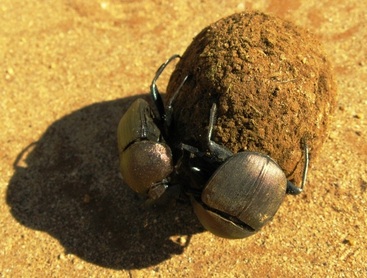 Imagine you are sitting under the shade of an Acacia tree, enjoying the beauty of the African savanna landscape. Suddenly you spot a small, hard ball of poop rolling along the ground, apparently of its own volition! Take a step closer, and you might catch a glimpse of one of the most important creatures in the savanna ecosystem – the dung beetle. Every day, millions of herbivores – including the ungulates that we are studying in the Masai Steppe Ecosystem – eat tons of grass, excreting vast amounts of seed-filled dung. Dung beetles disperse, feast upon, and live within these droppings, which provide a nutrient-rich food source for the beetles’ larvae. This may seem a lowly, rather unenviable lifestyle, but entomologists now understand that the savannah and many of its plants and animals completely depend upon the ecosystem services provided by dung beetles. More than 100 species of dung beetle have been recorded in Serengeti National Park alone, with different strategies in how they utilize the dung. “Roller” beetles create a ball of dung up to 40 times their body weight and can transport it up to 70 meters away, thus spreading nutrients far and wide. “Tunneller” beetles bury their balls of dung, helping the plant seeds within to germinate. Without these beetles, the ground would quickly be covered in a thick layer of dung, smothering the grasses that ungulates depend on for food. Even the lowliest members of an ecosystem play critical roles in the intricate web of life.
1 Comment
sharon
2/17/2015 01:42:32 am
love it!
Reply
Your comment will be posted after it is approved.
Leave a Reply. |
Science News and Updates From the Field from Wild Nature Institute.
All Photos on This Blog are Available as Frame-worthy Prints to Thank Our Generous Donors.
Email Us for Details of this Offer. Archives
July 2024
|
|
Mailing Address:
Wild Nature Institute PO Box 44 Weaverville, NC 28787 Phone: +1 415 763 0348 Email: [email protected] |
|

 RSS Feed
RSS Feed
